Why The Eisenhower Matrix Isn’t What You Think It Is
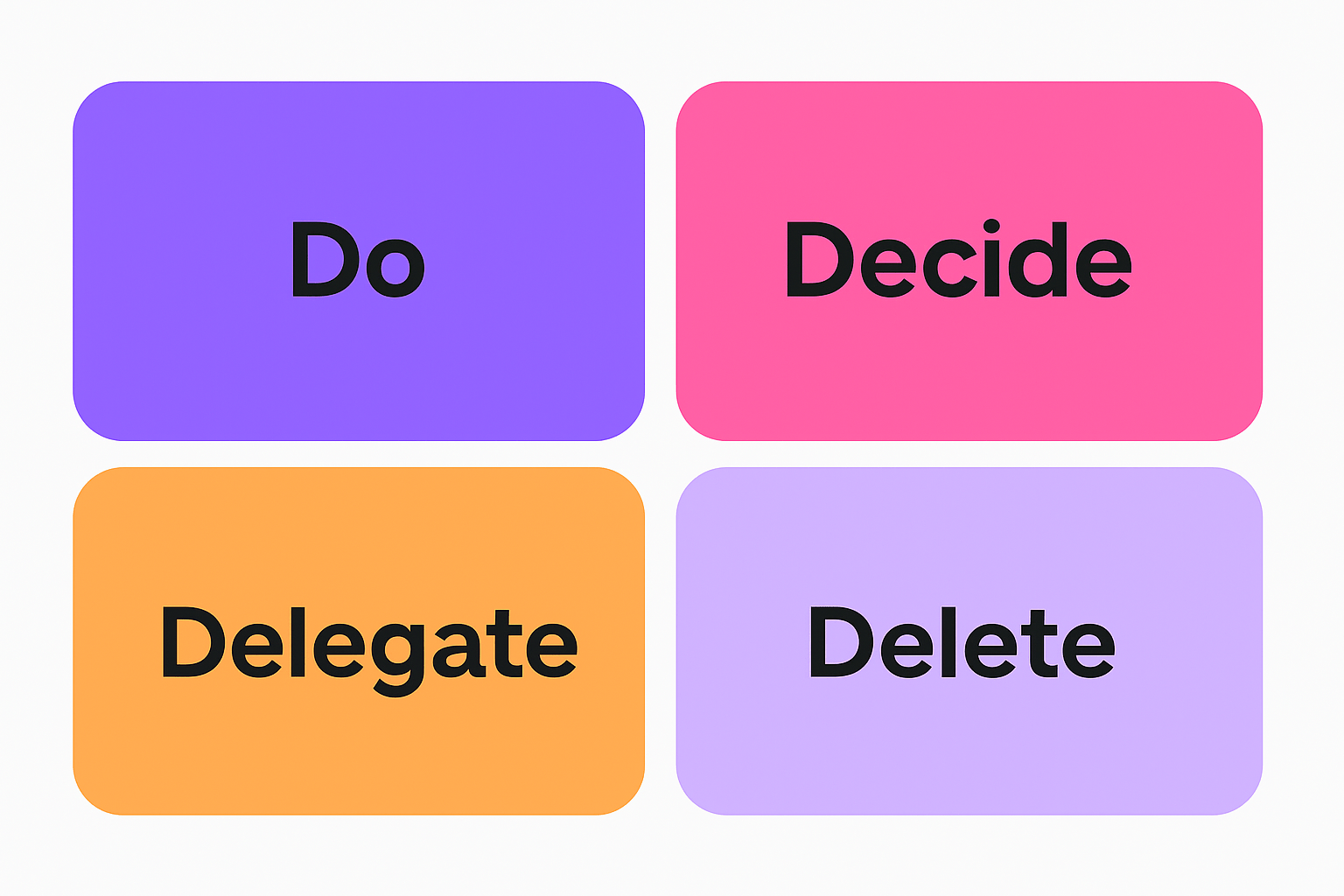
Sorry, there were no results found for “”
Sorry, there were no results found for “”
Sorry, there were no results found for “”
At 9:12 a.m., a product director shuts her laptop for the third time that morning. The Slack sidebar is glowing red with pings. The inbox count has doubled since breakfast. Her calendar looks less like a plan and more like a fire drill: “quick sync,” “urgent review,” “five minutes?” Meanwhile, the project that could change next quarter’s revenue forecast—her real priority—sits untouched on the bottom of her task list.
Nothing is technically on fire. But the day already feels like an emergency.
This isn’t laziness. It isn’t even poor time management. It’s how our brains are wired. We treat every request with a deadline as if it were life-or-death, even when the consequences are trivial. Psychologists call it the Mere Urgency Effect: the tendency to favor what’s loud and immediate over what’s meaningful.
That bias is expensive. When work is dictated by urgency alone, we burn hours on shallow tasks and leave high-value projects gathering dust. The result? Exhaustion, without the satisfaction of progress.
Enter the Eisenhower Matrix.
This deceptively simple framework—urgent versus important—offers a counterweight to the chaos. It doesn’t promise superhuman productivity. What it delivers is more valuable: perspective. By forcing a distinction between what clamors for your attention and what actually matters, the Eisenhower Matrix helps you reclaim focus, lower stress, and make sure your workday drives outcomes you care about.
Think of the Eisenhower Matrix as your personal decision-making assistant.
This deceptively simple four-quadrant framework (urgent or not urgent, important or not important) forces you to distinguish between what feels urgent and what actually drives results.
But here’s the catch: The matrix’s main benefit ISN’T making you more productive.
It’s helping you take charge of your life instead. 👇🏼
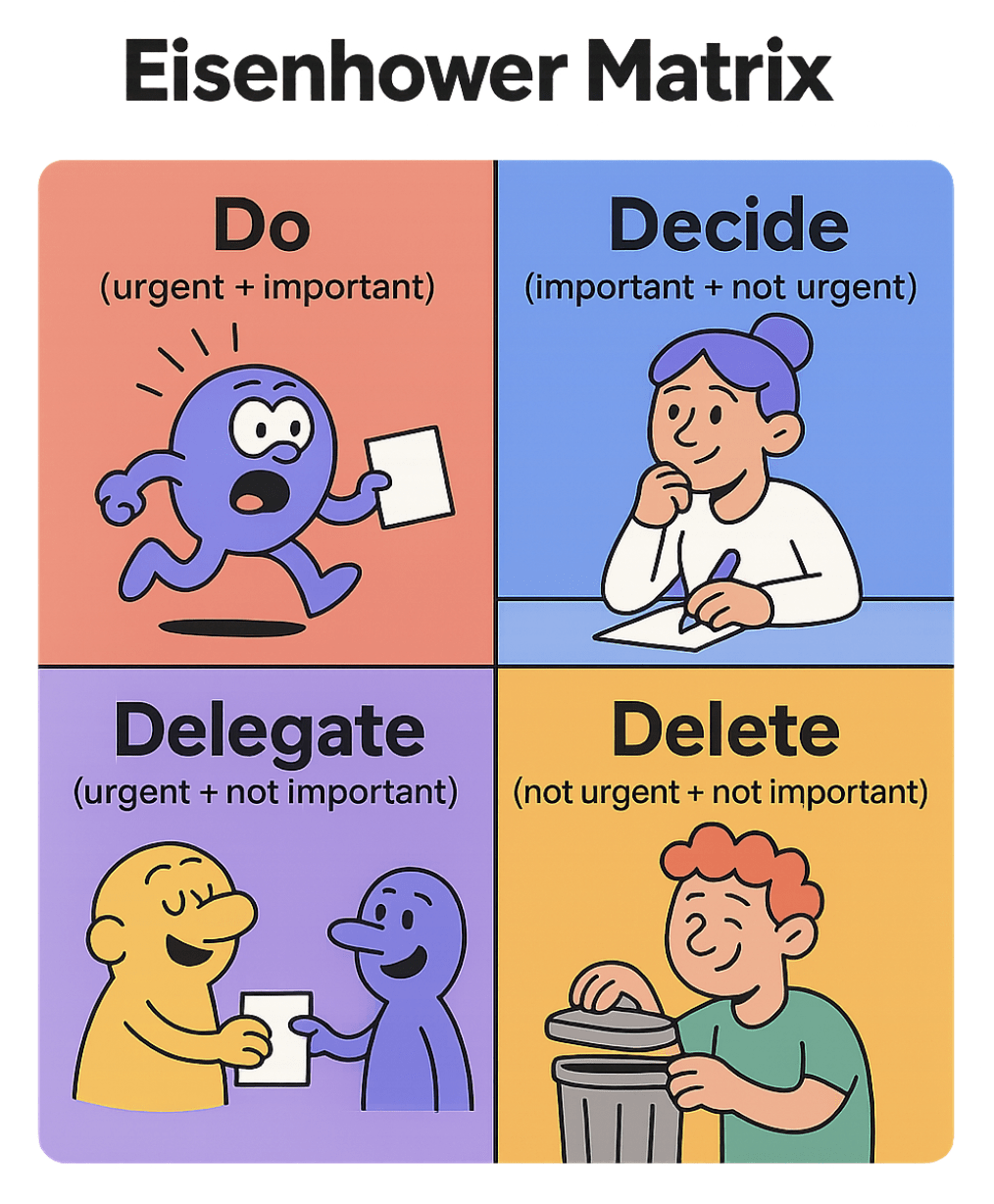
Research shows that people who use prioritization frameworks report way higher perceived control over their time AND lower stress levels, even when their raw output doesn’t dramatically increase (more on this in a bit).
Turns out the real enemy isn’t your to-do list. Your brain can’t tell the difference between a saber-toothed tiger and a Slack notification.
Fine, our brains are buggy. But is it all the brain’s fault? Not quite.
Modern life is full of distractions—from your phone, work laptop, Alexa, and even your Roomba! (Give me a break?).
If you’re on a team that juggles 15+ tools, research says you’re four times more likely to be stuck in the productivity slow lane. No wonder 42% of our working hours get chewed up by context-switching chaos.
So, what do we do? We invent our own time management hacks (92% of us, to be exact) while about 76% of us swear by our personal prioritization systems.
Yet 65% admit they’re just checking off the easy or urgent tasks while the real game-changers gather dust.
Enter the Eisenhower Matrix: the OG “stop kidding yourself” tool.
It slices through the noise, forcing you to face what’s actually important.
The Matrix is your reality check, your productivity compass, and your best shot at making sure your workday actually matters.
| Quadrant | Action | Description | Examples |
| Quadrant 1: Urgent + Important | DO | Real crises that require immediate attention | The server is down, and customers can’t buy anything |
| Quadrant 2: Important + Not Urgent | DECIDE | Writing a business plan, learning new skills, and going to the gym | Writing a business plan, learning new skills, or going to the gym |
| Quadrant 3: Urgent + Not Important | DELEGATE | Other people’s priorities that seem urgent but aren’t important to your goals | Most emails, random interruptions, or meetings that could have been emails |
| Quadrant 4: Not Urgent + Not Important | DELETE | Time-wasting activities that do not contribute to your goals | Social media rabbit holes, reorganizing your desk for the third time this week |
And suddenly, you know exactly which one requires your attention!
🛠️ Ready-to-use toolkit: ClickUp’s Eisenhower Matrix Template, which provides a pre-built structure that automatically sorts tasks into quadrants and adapts as your priorities shift.
Plus, you can easily convert your matrix items into tasks on ClickUp AND drill down into each quadrant of your matrix for greater depth.
We mentioned this before: Your brain has a bug.
When something feels urgent, your prehistoric alarm system tricks you into believing it’s important too.
The ancestors hear you.
Your brain is running prehistoric software in a world that’s been updated at breakneck speed.
For over 95% of human history, our ancestors’ anxiety was a finely tuned alarm system, primed to keep them alive in the wild (Nesse, 2022; Stein & Nesse, 2016). Back then, a rustle in the bushes could mean a predator, so a surge of anxiety made perfect sense.
Fast-forward to today, and our environments have changed faster than our biology can keep up—agriculture is only 10,000 years old, electricity is just a century old, and digital overload is barely out of diapers.
Our brains, still wired for saber-toothed threats, now react to emails, deadlines, and social media pings with the same primal urgency.
The mismatch is real: What once kept us safe now sometimes leaves us feeling overwhelmed by “threats” our ancestors couldn’t have dreamed of. So, if your anxiety feels out of place, it’s not a personal flaw. It’s your ancient brain doing its best in a brand-new world.
And that brings us to the next bit.
It’s Tuesday afternoon, and your inbox is full—47 emails the font size and margins of the quarterly report. You answer them all. The career-making project? Still untouched. Why?
Lunch has a deadline. The project doesn’t. Your brain picks lunch every time.
Because the Mere Urgency Effect kicks in, which is particularly pronounced for people who perceive themselves as busy.
Your brain doesn’t care about pay, growth, or impact. It sees a deadline and goes caveman. And the busier you feel, the worse it gets. Overwhelm fuels bad prioritization, which makes you busier, which makes you worse at prioritization. A vicious cycle.
Researchers who unveiled the “Mere Urgency Effect” found one way to break the cycle: make the outcomes of important tasks more obvious. (Why didn’t we think of that!)
When people could clearly see what they’d gain from the important work, they were more likely to ignore the urgent distraction.
This is exactly what the Eisenhower Matrix does; it interrupts the Urgency Trap and forces you to ask:
Is the task screaming at me actually moving the needle? Or am I just chasing the dopamine rush from crossing something off my list?
Ask anyone who’s used the Eisenhower Matrix for a month, and they’ll tell you the same thing: their output hasn’t doubled. Their stress has halved.
That’s the hidden power here. The Eisenhower Matrix doesn’t exist to squeeze more hours from your day. It exists to give you control over how those hours feel. Productivity may or may not increase. But calm? That’s guaranteed.
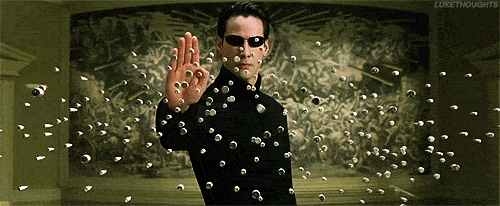
Any productivity achieved is just a welcome side-effect.
In fact, there’s a whole bunch of research that demolishes the myth that time management mind models make you more productive. In reality, they do something else entirely.
The most important time management research came from Therese Macan in 1994. She wanted to determine whether time management actually helped people get better at their jobs.
Spoiler alert: it didn’t.
Macan tested time management behaviors with a large sample of employees. People who used goal setting and prioritizing felt way more in control of their time. They were less stressed and happier at work.
Their bosses didn’t think they performed any better.
Perhaps the primary benefit of time management is not in its effect on performance, but in its effect on attitudes.
A 2010 study by Häfner and Stock took this further.
They gave some employees time management training. The trained group felt more in control and less stressed. But they didn’t actually get better at their jobs according to any measurable metric.
The results of our study demonstrate that increased perceived control of time leads to a decrease in strain and an increase in self-reported performance
💁♀️ Translation: Time management frameworks are therapy, not productivity boosters.
Dwight D. Eisenhower didn’t invent the Eisenhower Matrix. He didn’t even use a 2×2 grid.
What he did was popularize the core principle that would later become every productivity guru’s favorite framework.
Understanding this distinction reveals why the matrix works and why it sometimes doesn’t.
Before becoming president, Eisenhower was the Supreme Allied Commander during WWII.
He planned D-Day. He managed generals who thought they were smarter than him. He dealt with Churchill and Stalin on the same day (jeez).
When Eisenhower talked about urgent versus important, he wasn’t pontificating about inbox zero.
He was talking about the difference between reacting to Hitler’s latest move and planning the invasion that would end the war.
His ability to stay focused on what mattered while the world burned made him the poster child for a prioritization framework.
The famous line about urgent and important problems? Eisenhower said it, but he was quoting someone else.
I have two kinds of problems, the urgent and the important. The urgent are not important, and the important are never urgent.
He delivered this during a 1954 speech, explicitly crediting it to an unnamed former university president. That president was later identified as Dr. J. Roscoe Miller of Northwestern University.
Eisenhower’s own words from a 1961 address capture the real struggle:
Who can define for us with accuracy the difference between the long and short term! Especially when our affairs seem to be in crisis, we are almost compelled to give our first attention to the urgent present rather than to the important future
The most important detail? Even the man who planned the liberation of Europe felt the pull of urgent but pointless tasks.
Stephen Covey took Eisenhower’s insight and turned it into the four-square grid we know today.
In his 1989 book The 7 Habits of Highly Effective People, Covey created the visual framework that made the concept stick.
Eisenhower provided the wisdom. Covey provided the worksheet.
👉🏽 Want a quick video-led explanation? Here you go!
Each quadrant in the Eisenhower Matrix is basically a strategic zone with a specific action command and psychological state.
Here’s a quick look at how these quadrants affect your behavior:
| Quadrant | Core Emotion | Typical Behavior | Strategic Goal |
| Q1: Urgent + Important | Stress, pressure | Firefighting, reacting | Contain and reduce over time |
| Q2: Not Urgent + Important | Clarity, control | Planning, deep focus | Protect and expand |
| Q3: Urgent + Not Important | Guilt, obligation | People-pleasing, task-hopping | Delegate or minimize |
| Q4: Not Urgent + Not Important | Numbness, boredom | Avoidance, procrastination | Eliminate or limit |
💡Pro Tip: Before sorting tasks, scan your emotional state. If your workday feels like a game of whack-a-mole, you’re likely stuck in Q1 or Q3. Your real leverage lives in Q2.
This is the place for all those urgent and important action items.
Think genuine emergencies, pressing problems, and projects that have reached their final deadline.
Welcome to the home of not urgent and important tasks. Where long-term success is designed and built.
Here we meet the posers: All those urgent and not important tasks. 🌚
Imagine a fake productivity zone filled with tasks that scream for attention but don’t advance your core objectives.

Hello, trash can? 🗑️
Maybe that’s a bit harsh. But these tasks offer no real value and actively detract from a well-lived life.
👉🏽 Also Read: Free Decision-Making Templates in Excel, Docs & ClickUp
The Eisenhower method works best as a daily practice, not a one-time exercise.
Spend 10 minutes writing down every task, project, and obligation competing for your attention. Don’t filter yet. Just dump.
This is the most critical step. Write down your top 3-5 goals for the current quarter. A task is only “important” if it directly contributes to one of these goals. Everything else is, by definition, not important.
Go through your brain dump and place each item in its appropriate quadrant. Be honest. That “urgent” email from your colleague might actually be a Q3 interruption disguised as work.
Q2 tasks don’t have deadlines screaming at you, so they get perpetually postponed. Schedule specific time blocks for your most important Q2 work and treat those blocks as sacred as any client meeting.
💡Pro Tip: Using ClickUp Tasks, you can convert matrix items into tasks and even delegate them to your team members. Plus, you can always assign time estimates to stay on track.
Q3 tasks are the enemy of Q2 progress. Build systems to minimize them:
💟 Bonus: How often should you update your Eisenhower Matrix?
Daily reviews work best. Spend 5-10 minutes each morning sorting new tasks and adjusting priorities based on overnight changes. Weekly reviews help you assess whether you’re actually spending time in Q2 or just talking about it.
The Eisenhower Matrix often fails for the same predictable reasons.
(Don’t worry—each one has a fix, too!)
Everyone thinks their next project will be different.
This time you’ll finish early. This time there won’t be surprises.

You’re wrong. You’ve been wrong before. You’ll be wrong again.
The planning fallacy is real: You underestimate how long tasks take, even when you have data proving you always underestimate how long tasks take.
For example, say you put “Write marketing strategy” in Q2 and schedule it for Friday afternoon. The reality? It needs data from three departments, two approval rounds, and legal review. Two weeks later, it’s a Q1 crisis because the board meeting is tomorrow.
Suddenly, you realize this isn’t a Friday afternoon task.
🧠 The fix: Break big tasks into small ones. “Write marketing strategy” becomes “Get sales data from Jake,” “Review competitor pricing,” and “Draft positioning section.”
Urgency is objective. The deadline is Friday, or it’s not.
Importance is subjective. Too often, it gets hijacked by whoever talks the loudest or has the highest title.
Your boss’s “quick question” feels important because it came from your boss. But does it actually move your goals forward? Probably not.
🧠 The fix: Write down your actual goals for the quarter. Treat tasks that directly support those goals as top priority. If something else pops up, ask: Does it support the broader company mission, unblock a teammate, or prevent bigger issues later? If not, it probably isn’t important—no matter how urgent it feels.
The Eisenhower Decision Matrix says Q3 tasks should be delegated.
Cool. To whom?

If you’re a solo founder, student, or anyone without direct reports, “delegate” is fantasy advice. It’s like being told to “just hire someone” when you’re bootstrapping.
🧠 The fix: Replace “delegate” with “minimize, automate, or batch.”
Can this meeting be an email? Can you set up an autoresponder? Can you batch all these interruptions into one hour instead of letting them destroy your whole day?
Most Q3 tasks don’t need to exist. They’re just habits disguised as work. Like responding to the same question for the 10th time! Just set up an AI-powered answer agent, like this one here.👇🏼
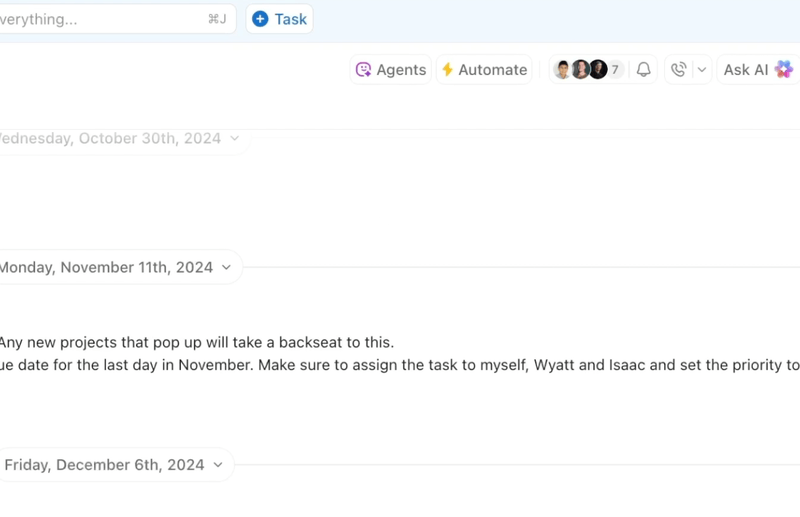
Your priorities change. A Q2 task today might become a Q1 crisis tomorrow.
And a paper to-do list? It’s outdated the second you write it.
Plus, like this Reddit user says:
I have so many tasks that I have no idea how to place in an Eisenhower matrix. I’ve always loved the concept. I’ve never been able to apply it
🧠 The fix: Use a dynamic system. For example, with ClickUp, you can build a living, adaptable priority matrix:
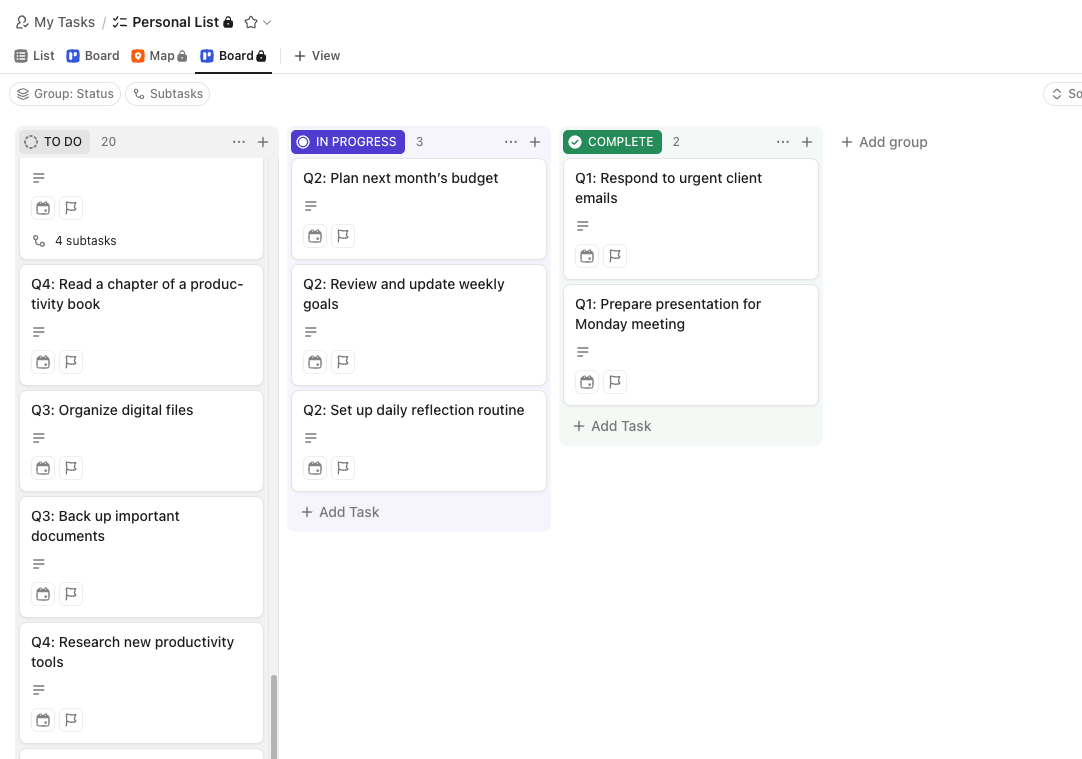
Everyone thinks they need the Eisenhower Matrix. Not everyone actually does.
But if you’re drowning in competing demands and can’t tell the difference between a real emergency and someone else’s poor planning, keep reading.
Your biggest enemy isn’t the competition. It’s the illusion that everything crossing your desk is equally important.
As a CEO, you’re paid to think strategically, not to personally respond to every vendor email or approve every social media post. The Eisenhower method forces you to protect your most valuable resource: time for actual leadership.
👉🏽 Reality check: If you’re spending more time in Q1 (crisis mode) than Q2 (strategic planning), you’re not leading—you’re just the highest-paid firefighter in the building.
👉🏽 Your Q2 sweet spot: Board preparation, long-term strategy, succession planning, and the kind of deep thinking that can’t happen between meetings.
🤔 Want to supercharge your strategic thinking? Kyle Coleman, GVP at ClickUp, explains how he keeps his priorities straight!
You wear every hat in your business. Customer service, marketing, accounting, product development—all of it lands on your desk.
The matrix helps you distinguish between tasks that grow your business (Q2) and tasks that make you feel busy but broken (Q3 and Q4).
For example, answering client emails within 30 seconds doesn’t make you more professional. It makes you a well-trained interrupt-response system.
👉🏽 Your survival strategy: Batch Q3 tasks into specific time blocks. Check email twice a day, not 200 times.
School is designed to make everything feel urgent. Every assignment has a deadline. Every test matters for your GPA. Every activity “looks good on college applications.”
The Eisenhower Decision Matrix helps you separate real learning (Q2) from academic busywork (Q3).
For example, spend three hours perfecting the formatting on a paper instead of actually understanding the concepts. Perfect formatting is Q3. Deep comprehension is Q2.
You’re caught in the middle. Executives dump strategic objectives on you. Your team escalates every minor decision to you. Clients want updates every five minutes.
The urgent-important matrix helps you figure out what actually needs your brain versus what needs your signature.
For example, your direct report can handle that “urgent” client check-in call (Q3). You can’t delegate the quarterly performance reviews that determine who gets promoted (Q2).
👉🏽 Manager trap: Thinking you’re irreplaceable. Most of your Q3 tasks exist because you haven’t trained your team to handle them.
Here’s what Gaurav Agarwal, the COO at ClickUp, says about that particular trap!
I recently made a shift in how I prepared my quarterly business review content:
Previously: I’d spend 20 hours personally getting data, formulating a story, creating slides
Now: My team spends 30 hours and I spend 5
That’s 35 total hours now vs. 20 before.Seems inefficient, right? Yet, this approach:
• Frees 15 hours of my time for higher-value work
• Produces a better end result than I could create alone
• Allows my team to develop a deeper understanding of the business
• Next time when we do this, 35 total hours will become 25 hours.
This is the productivity paradox of scaling: What looks like reduced efficiency at the unit level actually creates exponential gains at the system level

| Criteria | Individuals | Teams |
| Use Case | Personal productivity, habit formation | Shared prioritization, delegation, planning |
| Tools Needed | Notebook, app, or ClickUp template | ClickUp with shared fields, dashboards, automations |
| Benefits | Reduced stress, better focus | Clear accountability, reduced micromanagement |
💡Pro Tip: Use ClickUp Dashboards to monitor quadrant distribution across your team. If most of your team is living in Q1, it’s time to reinforce Q2 planning.
The Eisenhower Matrix isn’t the only game in town.
While it’s a solid starting point, some situations call for different approaches.
Think of these alternatives as specialized tools in your productivity toolkit—each designed to solve specific problems the matrix can’t handle.
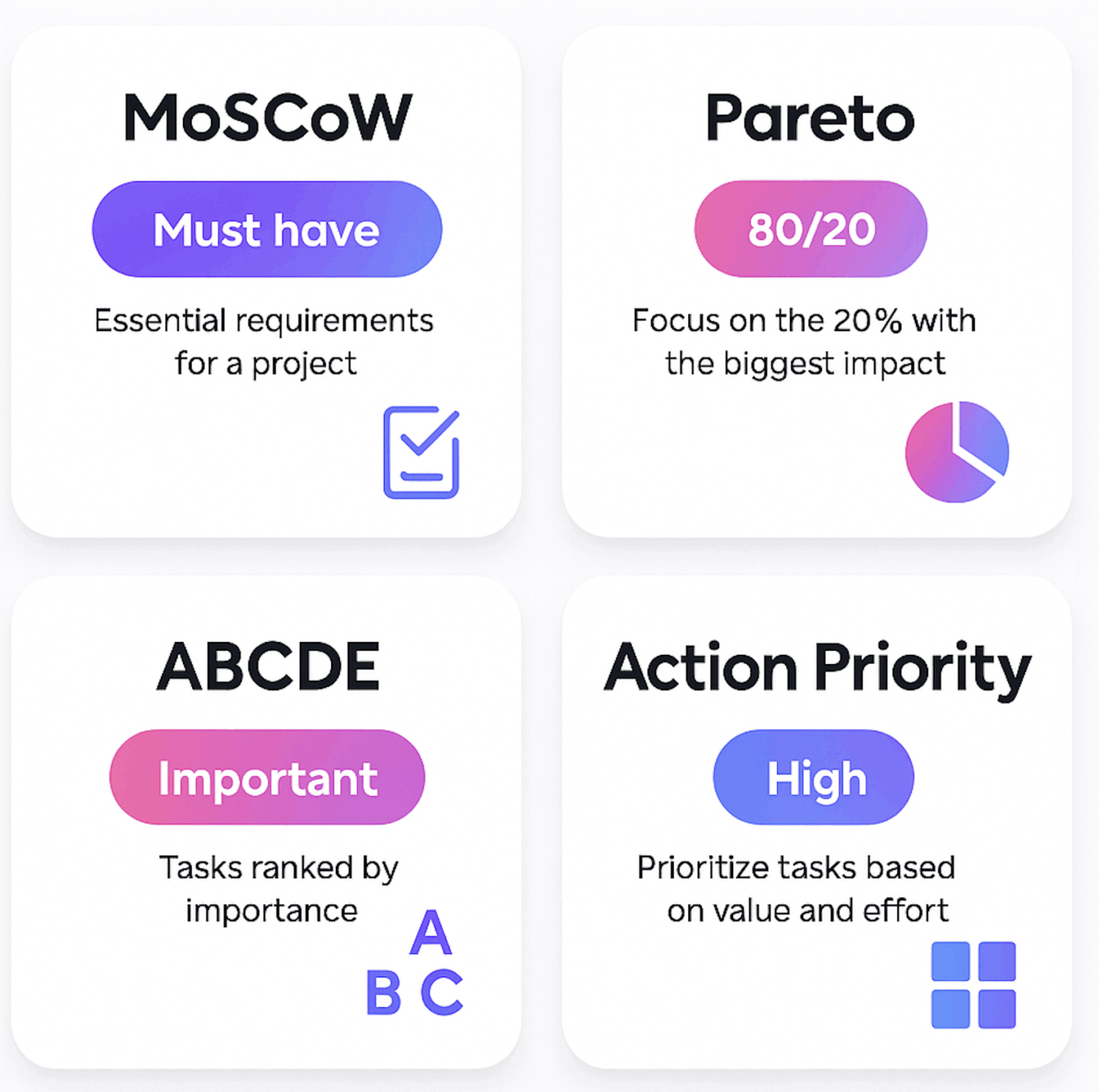
The Pareto Principle operates on a simple but powerful insight: 80% of your results come from 20% of your efforts. It’s not about sorting tasks but finding the small number of activities that create disproportionate value.
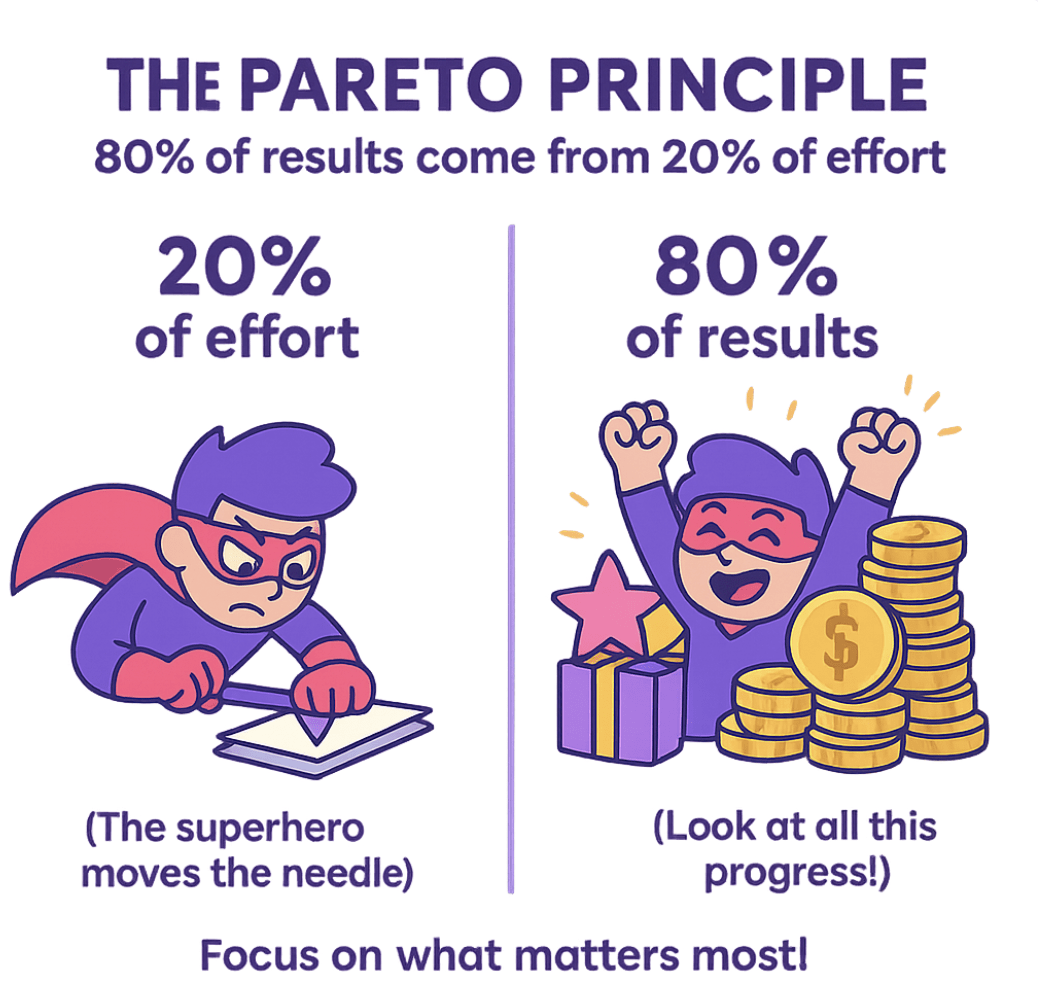
✅ When Pareto wins: You’re drowning in busy work but not sure which activities actually move the needle. The 80/20 rule forces you to look at your results and work backwards. Which 20% of your clients generate 80% of your revenue? Which 20% of your features create 80% of user engagement?
For example, a marketing manager realizes that 80% of qualified leads come from just 2 out of 10 marketing channels. Instead of trying to optimize all 10 channels equally (Eisenhower thinking), she doubles down on the two that work and kills the rest (Pareto thinking).
✅ When Eisenhower wins: You know what’s important, but can’t stop getting distracted by urgent-but-pointless tasks. Pareto analysis won’t help you ignore that Slack notification. The matrix will.
💡Pro Tip: Use both. Pareto analysis identifies your high-leverage activities (what goes in Q2). The Eisenhower Matrix protects time for those activities by filtering out everything else.
No, not the city. It’s actually an acronym: Must have, Should have, Could have, Won’t have.
| The MoSCoW Method (Explained) |
| Must Have Non-negotiable requirements that are critical for the current project increment or release |
| Should Have Important requirements that are not vital for the solution to function |
| Won’t Have (this time) Requirements that the team and stakeholders have explicitly agreed on will not be delivered in the current timeframe |
| Won’t Have (this time) Requirements that the team and stakeholders have explicitly agreed on will not be delivered in the current timeframe |
This framework was born in software development for one specific problem: deciding what features to build when you can’t build everything.
✅ When MoSCoW wins: You’re managing a project with multiple stakeholders who all think their requests are “urgent and important.” The Eisenhower method will break down because everyone’s definition of “important” is different.
MoSCoW forces hard conversations about what’s actually essential. “Must have” features are non-negotiable—if they’re not included, the project fails. “Should have” features are important but not deal-breakers. “Could have” features are nice-to-have bonuses. “Won’t have” features are explicitly out of scope.
Here’s the genius of “Won’t have” (this category doesn’t exist in the Eisenhower Matrix): It’s a formal way to say “not now, maybe later,” which prevents scope creep and manages expectations.
✅ When Eisenhower wins: You’re working alone or with a small, aligned team where scope isn’t the primary issue. MoSCoW adds unnecessary complexity for simple task prioritization.
The ABCDE method is the Eisenhower Matrix on steroids—and steroids come with side effects.
| ABCDE Task Management Method | ||||
| A | B | C | D | E |
| Very Important | Important | Nice to Do | Delegate | Eliminate |
| Must-do tasks with serious consequences if not completed | Should-do tasks with minor consequences. Beneficial but not critical | Tasks with no consequences. Enjoyable but no impact on goals | Tasks that can be assigned to others to free up time for A tasks | Unnecessary tasks that add no value |
| Golden rule: Never work on a B task when an A task exists. Never work on a C task when a B task exists. | ||||
Here’s how it works: Every task gets a letter.
And here’s the main rule: You never work on a B task while an A task exists. Never work on a C task while a B task exists. And so on.
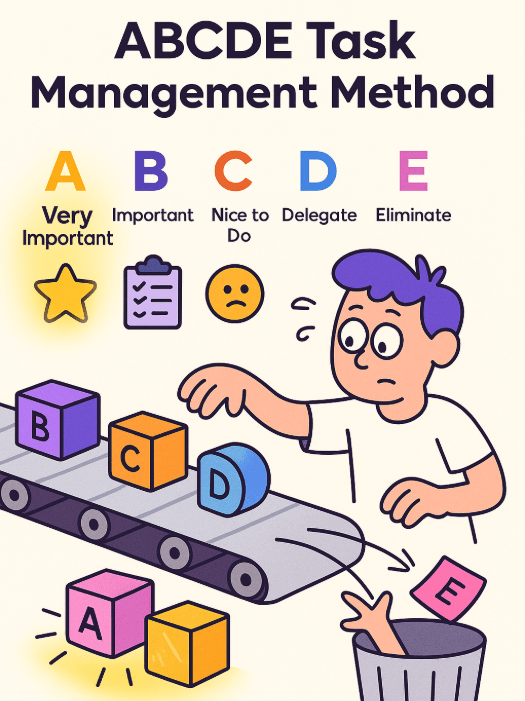
✅ When ABCDE wins: You’re a chronic procrastinator who gravitates toward easy, low-value tasks. The rigid “A-first” rule provides the discipline that the matrix lacks.
For example, your list includes “Respond to client proposal” (A), “Update LinkedIn profile” (B), and “Organize computer files” (C).
With Eisenhower, you might spend your morning organizing files because it feels productive. With ABCDE, that’s literally against the rules until the proposal is done.
✅ When Eisenhower wins: Your work environment is unpredictable. True emergencies pop up. Priorities shift. The ABCDE method’s rigidity becomes a liability when you need flexibility.
The biggest challenge with the ABCDE Method is that it assumes you have someone to delegate to. If you’re a solo entrepreneur, freelancer, or junior employee, “D” tasks become “B” or “C” tasks, potentially creating an unmanageable workload.
The Action Priority Matrix is the Eisenhower Matrix‘s business-school-educated cousin. Instead of “urgent” and “important,” it uses “effort” and “impact.”
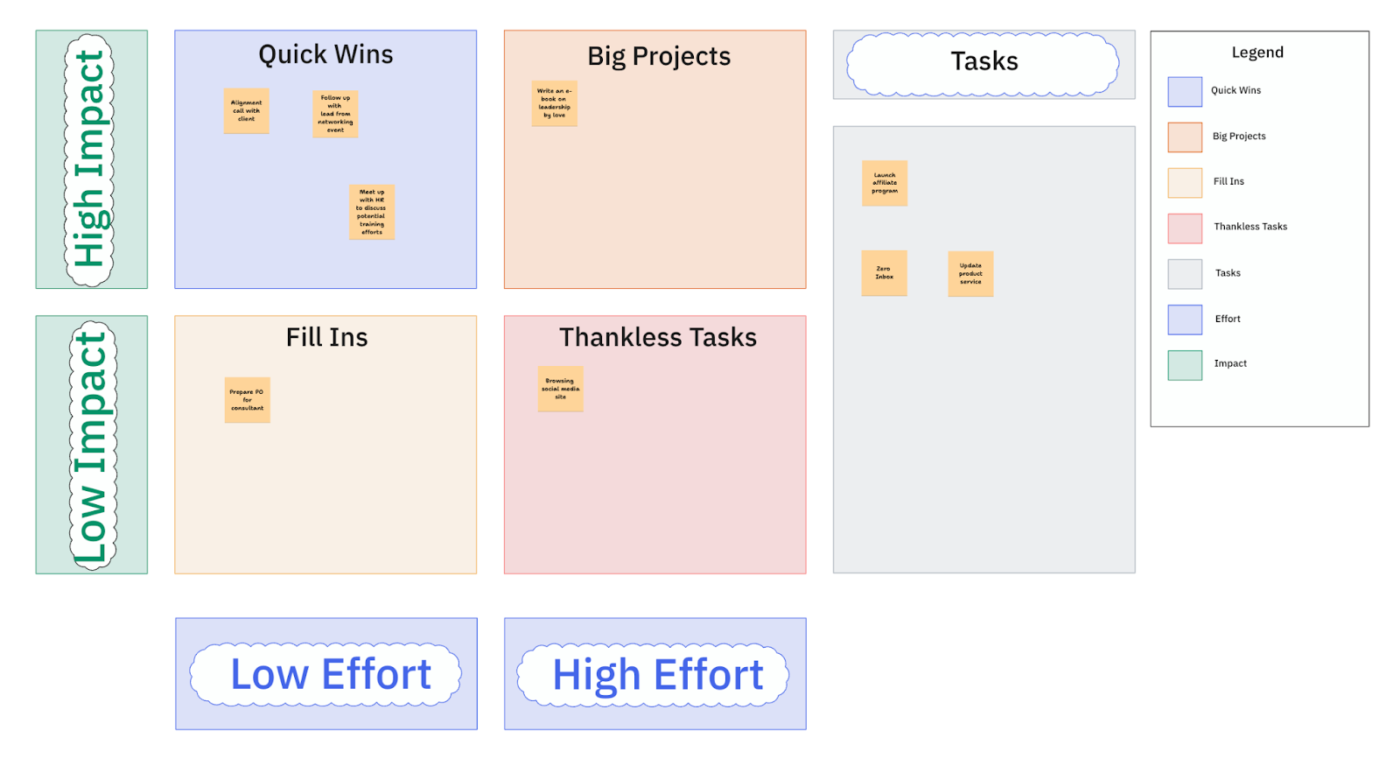
The four quadrants:
The key difference is that the Action Priority Matrix thinks in terms of return on investment; Eisenhower thinks in terms of deadlines and goals.
✅ When Action Priority wins: You’re managing resources (budget, team time, development hours) and need to justify decisions to leadership. “This has high impact and low effort” is more convincing than “this is important but not urgent.”
For example, a product manager choosing between features may use the matrix like this:
✅ When Eisenhower wins: You’re dealing with genuine time-sensitive work where deadlines matter more than ROI calculations. Customer emergencies don’t care about your impact/effort analysis.
The Eisenhower Matrix and Agile help you prioritize work—but they serve different functions and operate on different time scales.
| Framework | Primary use case | Focus area | Time horizon |
| Eisenhower Matrix | Daily decision-making for individuals | Urgency vs. importance | Immediate to short-term |
| Agile / Scrum | Team-based project delivery | Iterative planning and backlog management | Sprint-based (1–2 weeks) |
Agile is a team-based delivery methodology for shipping work in short, structured cycles. Frameworks like Scrum help teams plan work (via sprint planning), reflect on it (via retrospectives), and keep priorities flexible (via backlogs). Agile prioritizes collaboration, velocity, and iteration.
The Eisenhower Matrix, on the other hand, is a personal prioritization tool. It helps individuals triage tasks based on urgency and importance—especially useful when daily distractions threaten to derail long-term progress.
💡Pro Tip: Use the Eisenhower Matrix before sprint planning to identify which tasks are truly worth tackling. It’s a smart way to align your individual priorities with your team’s Agile delivery cycle.
| Framework | Eisenhower Matrix | MoSCoW Method | Pareto Principle (80/20) | ABCDE Method | Action Priority Matrix |
| Core Principle | Attribute-based Triage | Requirement-based Scoping | Asymmetrical Leverage | Consequence-based Sequencing | ROI-based Allocation |
| Key Categories | Urgency / Importance | Must / Should / Could / Won’t | 80% Outputs / 20% Inputs | A / B / C / D / E Consequences | Impact / Effort |
| Use Case | Strategic task management | Agile project delivery & scope management | Strategic analysis of activities | Disciplined personal execution | Business/project resource planning |
| Decision Focus | “What requires my attention now?” | “What must we deliver for a viable solution?” | “Where is my highest point of leverage?” | “What is the absolute next thing I must do?” | “What is the most efficient use of resources?” |
| Key Strength | Simplicity and conceptual clarity | Stakeholder alignment and scope control | Generates strategic insight | Enforces discipline and combats procrastination | Focus on Return on Investment (ROI) |
| Weakness | Oversimplifies interdependent work | No intra-category ranking | Rigidity in a dynamic environment | Rigidity in dynamic environment | Subjectivity in scoring impact and effort |
| Ideal User | Anyone who feels overwhelmed with their priorities | Agile Product Manager or project team | Strategic Analyst or leader seeking focus | Procrastinators needing more structure | Resource-constrained Team Lead or PM |
➡️ Start with Eisenhower if you’re new to prioritization or feeling overwhelmed. It teaches the fundamental skill of separating urgent from important
➡️ Add Pareto analysis quarterly to identify which 20% of your activities drive 80% of your results
➡️ Use MoSCoW for team projects where scope creep is a problem and stakeholders need alignment
➡️ Try ABCDE if you’re disciplined enough to follow strict rules and struggle with procrastination
➡️ Switch to Action Priority when you’re managing resources and need to make ROI-based decisions
➡️ Bring in Agile when you’re working with a team on deliverables that evolve over time. Agile helps you prioritize and ship work in short, iterative cycles—ideal for cross-functional collaboration, fast feedback, and adapting to change
But remember that none of these frameworks are magic bullets. They’re decision-making tools that force you to ask better questions about where you’re losing track of time.
The best framework is the one you’ll actually use consistently.
You’ve got the basics down.
Now let’s talk about the advanced moves that separate matrix amateurs from true prioritization masters.
With ClickUp, you can turn this simple 2×2 grid into a dynamic system that learns from your behavior and adapts to your reality.
Your brain processes visual information 60,000 times faster than text. Stop making your Eisenhower Matrix harder than it needs to be.
Instead, use ClickUp Task Priorities to match matrix quadrants with visual cues.
Set up Urgent + Important tasks with red flags, Important + Not Urgent with yellow, Urgent + Not Important with blue, and Not Urgent + Not Important with gray.

✅ Why this works: You can scan your task list in seconds instead of reading through descriptions. Red tasks jump out immediately. Yellow tasks remind you to schedule time blocks. Blue tasks scream “delegate me.” Gray tasks are candidates for deletion.
💡Pro Tip: Create custom tags for recurring Q2 activities like “Strategic Planning,” “Team Development,” or “Process Improvement.” This makes it easier to spot patterns in what you’re neglecting.
The biggest matrix failure is when important tasks sit in Q2 until their deadline, which makes them urgent. ClickUp Automations can prevent this.
Create rules that automatically move tasks from Q2 to Q1 based on due dates. For example, “When the due date is 3 days away, change priority to Urgent and notify the assignee.”
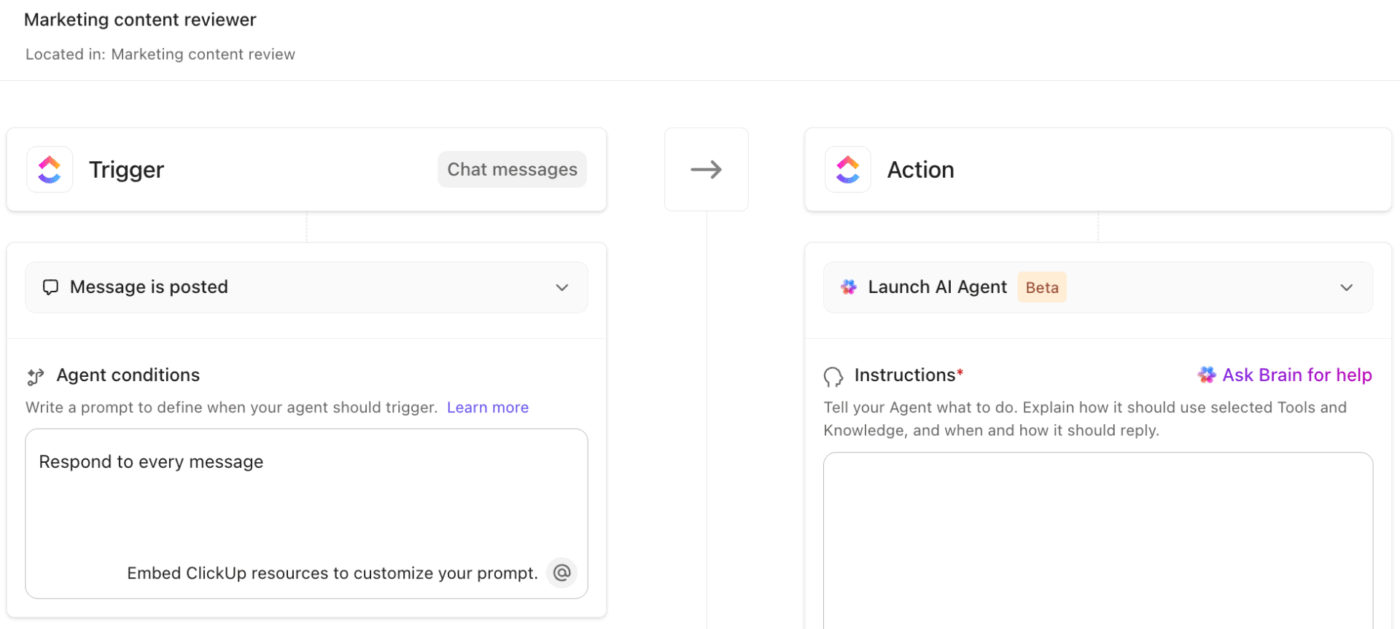
Advanced automation: Set up workflows that create recurring Q2 tasks. Monthly strategic reviews, quarterly goal assessments, and weekly team check-ins should automatically appear in your Q2 without you remembering to add them.
🧠 The game changer: Use Agents in ClickUp to delegate Q3 tasks automatically. Set rules like “When a task is tagged ‘Routine Admin,’ assign to [Colleague Name] and notify via Slack.”
Here’s where it gets interesting.
ClickUp Brain can analyze your task history and spot patterns you’re missing.
For example, one of our favorite AI prompts for the Eisenhower Matrix is:
“Analyze my completed tasks from the last month. Which 20% of activities generated 80% of my results? What Q2 tasks did I consistently postpone, and what were the consequences?”
ClickUp Brain can identify:
And that, folks, is the power of contextual AI.
🎥 See how contextual AI can transform your work with “actual” smart prioritization.👇🏼
Q2 work dies from a thousand small cuts—emails, Slack messages, “quick questions.”
The solution isn’t willpower. It’s architecture.
The ClickUp setup: Use the ClickUp Calendar to create two types of time blocks:
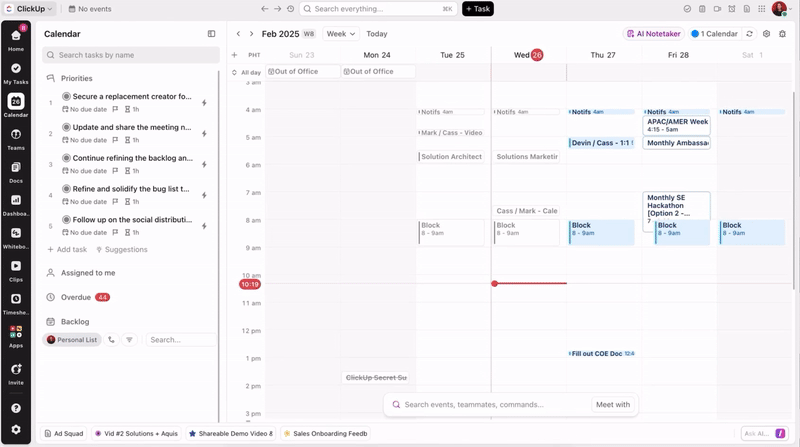
Most people are terrible at distinguishing important from urgent because they think about how they feel right now, not about consequences.
For each task, ask: “If my future self could send me a message, would they thank me for doing this task, or regret the time I spent on it?”
In ClickUp, you can add a Custom Field called “Future Self Rating” with options like “Will Thank Me,” “Won’t Matter,” or “Will Regret.”
Or use numbered rating, i.e., 0 = This didn’t go as planned. 🙄
This forces you to think beyond immediate pressure.
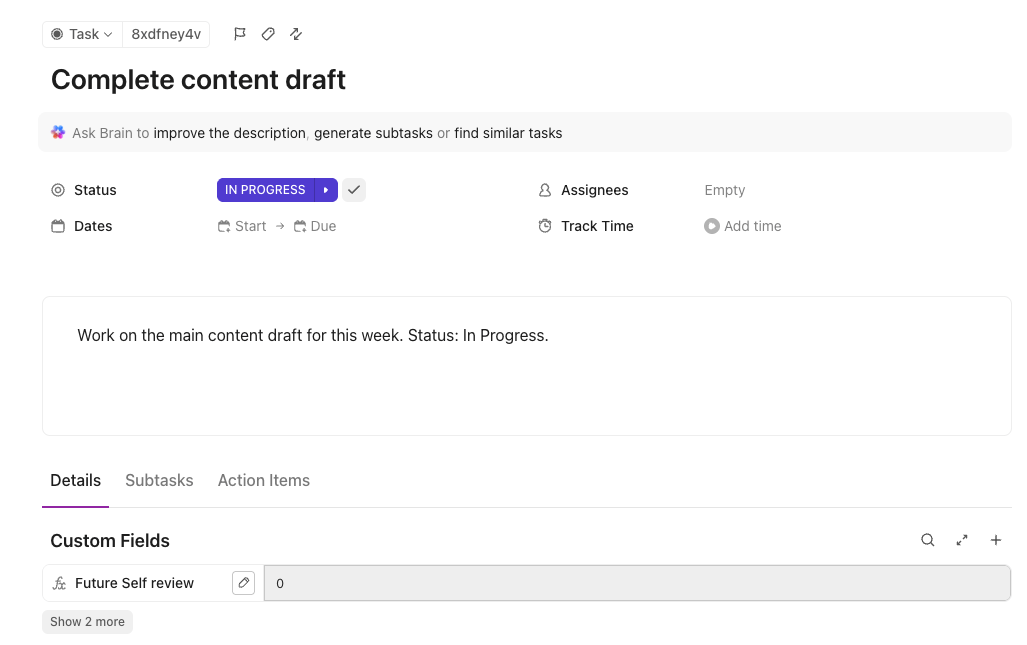
💡The 10-10-10 rule: How will you feel about this task in 10 minutes, 10 months, and 10 years? Use ClickUp’s task descriptions to note this analysis for borderline cases.
Each week, compare the time spent in each quadrant against your intended allocation. Most people discover they’re spending 60% of their time in Q3 while planning to spend 60% in Q2.
Ask these questions:
ClickUp’s Project Time Tracking reveals the brutal truth about where your time actually goes versus where you planned to spend it. Use this data to improve your time estimates and identify which Q3 tasks need systematic solutions rather than constant attention.
Track when you’re most effective at different types of work.
For two weeks, log your energy level (1-10) every hour using ClickUp’s time tracking notes. Cross-reference with task completion quality and efficiency.
Most people find they have 2-4 hours of peak energy for Q2 strategic work. Protect these hours ruthlessly.
ClickUp optimization: Schedule your most important Q2 tasks during proven peak hours. Use automated time blocking in ClickUp Calendar to automatically block these times based on your backlog, priorities, and meetings.
Energy-task matching:
Individual matrices work. Team matrices with shared accountability work better.
Weekly matrix reviews: Use ClickUp AI cards to review:
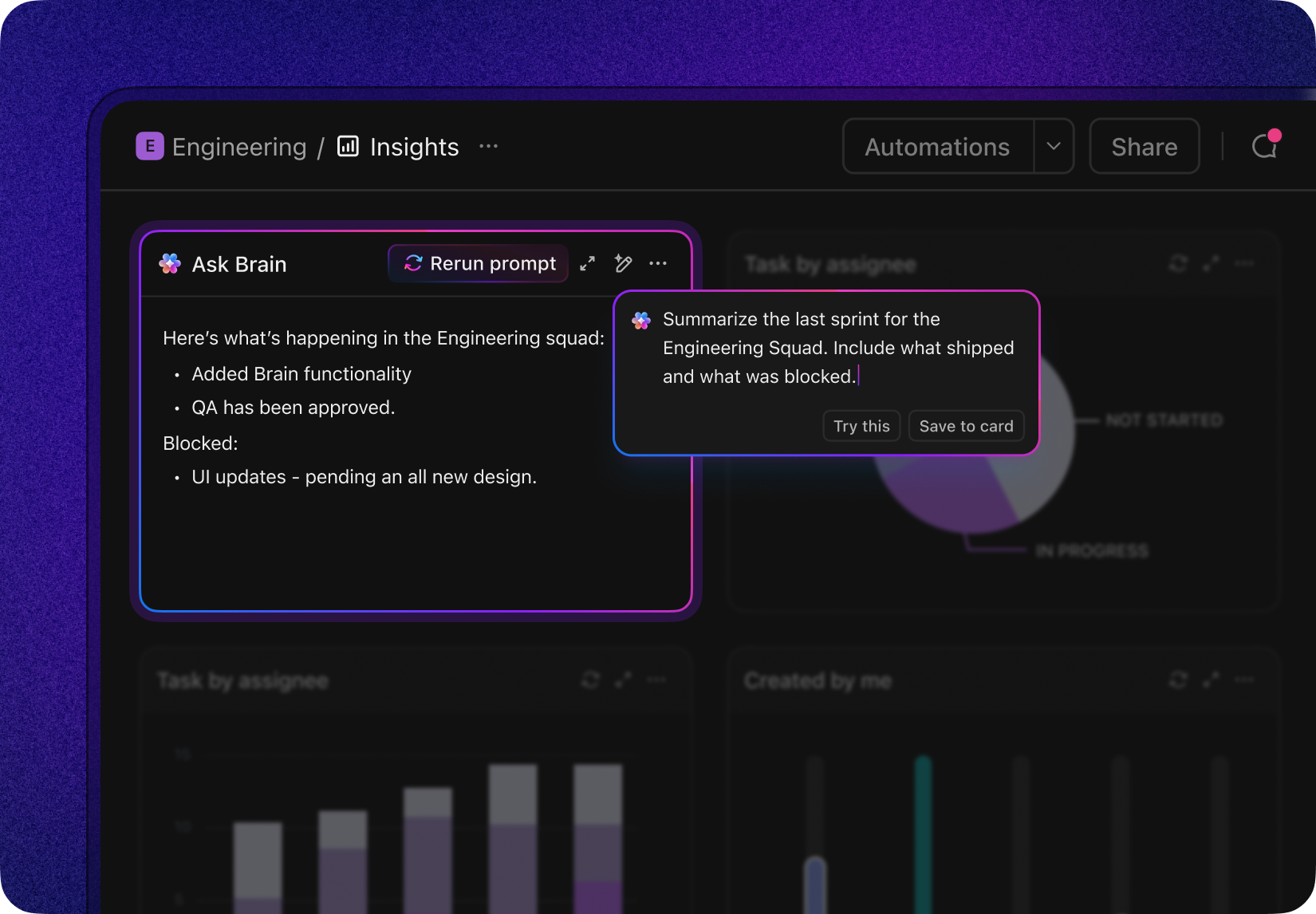
Make Q2 time blocks visible to your team through shared calendars. When everyone sees that 9-11 AM is protected Q2 time, they’re less likely to interrupt.
💡Pro Tip: In weekly team meetings, ask: “What Q2 work did we protect this week, and what Q3 distractions did we eliminate?”
The Eisenhower Matrix is a decision-making lens that flexes with your role, goals, and work environment.
Whether you’re leading cross-functional projects or juggling freelance clients, here’s how to apply it across different contexts.
In roles with complex workflows—marketing, engineering, design—the real challenge isn’t lack of effort; it’s decision fatigue. The matrix externalizes those decisions so you can focus on impact.
Solopreneurs, creatives, and founders often confuse momentum with progress. The Eisenhower Matrix helps you break the loop of reacting to everything that pings.
💡Pro Tip: Use ClickUp Recurring Tasks to schedule morning reviews and end-of-day audits. Add time estimates to Q2 tasks to stay scoped and focused.
When your team is spread across time zones, real-time prioritization falls apart. The matrix introduces a shared mental model—without constant check-ins.
💡Pro Tip: Automate task shifts in ClickUp: “If urgency = high and due date < 3 days → move to Q1 and notify assignee in Slack.” ClickUp Automations help enforce this dynamically.
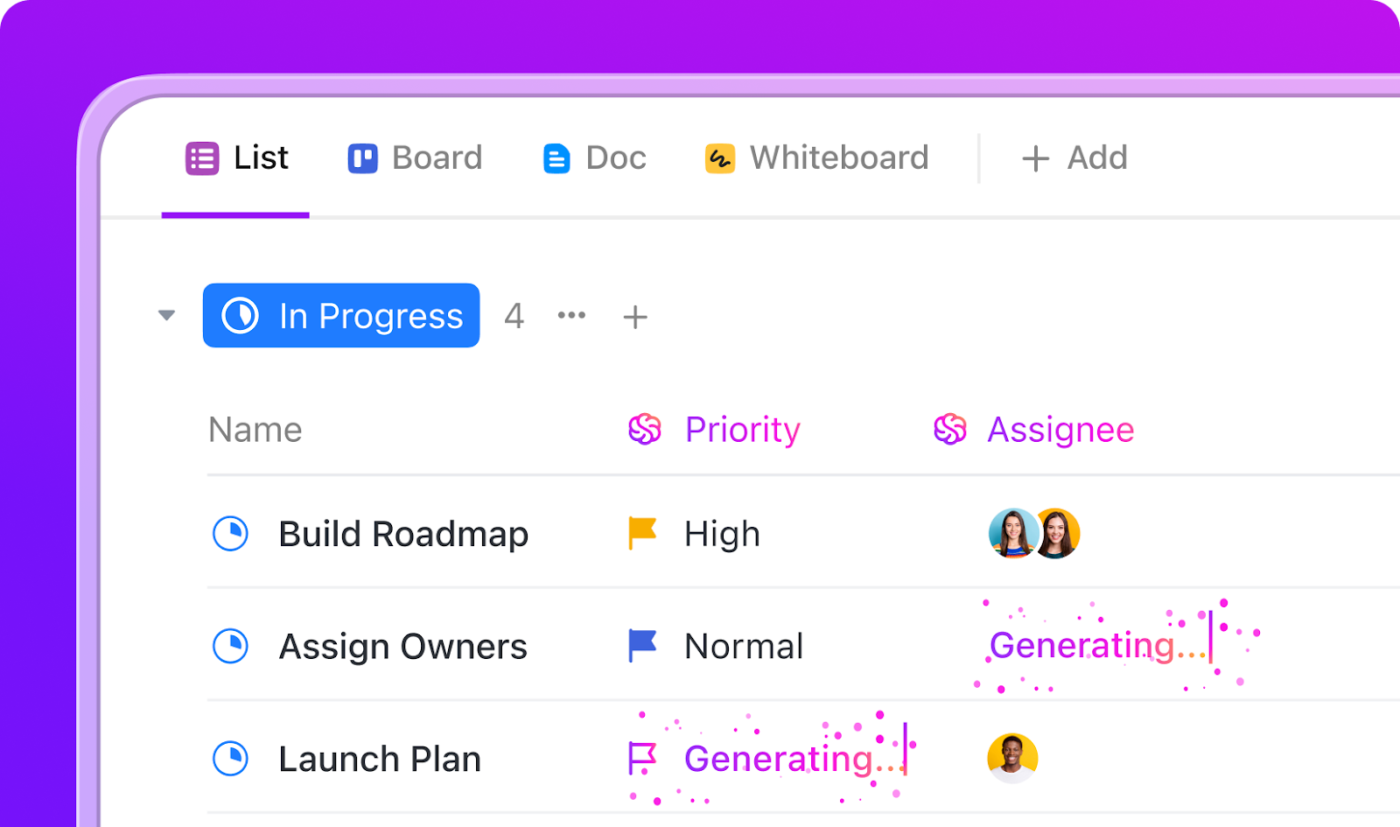
Some jobs live in Q1 (support, ops). Others thrive in Q2 (strategy, leadership). Your ideal quadrant depends on your role and energy rhythms.
| Role | Primary Quadrant | Focus |
| Founder/Product Lead | Q2 | Vision, delegation |
| Ops Manager | Q1/Q3 | Crisis management, triage |
| Designer/Marketer | Q2 | Deep work, planning |
| Support Agent | Q1 | Real-time response |
❗️What does this mean? The Eisenhower Matrix allows you to design your day with intention. Your quadrant balance should reflect your goals, not your inbox volume.
📖 Read More: Eisenhower Matrix Examples
Theory is nice. Application is where the rubber meets the road.
Sarah opens her laptop to find a dismaying number unread emails, three Slack channels with red notification badges, and a calendar packed tighter than a Tokyo subway car.
Her Eisenhower breakdown:
Sarah discovers that most of her Q1 “emergencies” are actually Q3 tasks that other people labeled as urgent. The password reset issue is real Q1. The CEO’s request for “quick” competitive analysis that’s due “soon” is Q3 masquerading as Q1.
Jake has four projects running simultaneously. Two clients just sent “urgent” revision requests. A new prospect wants a quote. His portfolio website needs updating.
His matrix reality:
Jake’s been treating every client request as Q1 because he’s afraid of losing business. In reality, clients respect boundaries. The ones who don’t are probably not clients worth keeping.
Maria needs to balance her marketing director job, two kids under 10, and maintain some semblance of personal sanity.
Her family matrix:
For Maria, being a “good parent” isn’t about saying yes to every school activity. It’s about being present for the moments that matter.
The Eisenhower Matrix gives you something better than productivity: perspective.
It’s not about doing more. It’s about finally seeing the difference between tasks that demand your time and tasks that deserve it.
When you revisit your matrix daily, you’re not just crossing off to-dos. You’re making a choice:
→ Less panic. More intention
→ Fewer fake fires. More strategic progress
→ Less time spent reacting. More time spent building what matters
And when you use a system like ClickUp, your matrix becomes dynamic—it grows with you, protects your Q2 time, and helps you delegate or delete everything else.
Because the most productive people are just better at saying: This is worth it. The rest can wait.
Try it. Escape the Urgency Trap—for good with ClickUp. Create a free account today!
The Eisenhower Matrix is a simple 2×2 framework that helps you separate what’s urgent from what’s important. Urgent tasks demand immediate attention, but important tasks drive long-term results. By sorting tasks into these quadrants, you stop reacting to every ping and start making intentional choices about where your energy goes.
Not exactly—the biggest benefit isn’t raw productivity. The real power of the matrix is giving you a sense of control. Once you see the difference between busywork and meaningful work, you feel less overwhelmed and more in charge of your day. Productivity is often just a side effect of having clearer priorities.
It’s best for anyone who feels buried under competing demands—students juggling assignments, managers stuck in meetings, founders wearing every hat, or executives constantly firefighting. If your day feels like one long reaction, the matrix helps you reclaim focus.
Pomodoro is about when you work (fixed 25-minute intervals with breaks). Eisenhower is about what you work on (separating important from trivial). They actually work well together—Eisenhower tells you what matters, Pomodoro helps you stay consistent in getting it done.
– Treating everything your boss or client asks as “important”
– Putting big, vague projects into Q2 without breaking them down
– Thinking delegation is always possible (it’s not—sometimes you need automation or batching instead)
– Using it once as a to-do list instead of a daily practice
Not at all. The framework has been around for decades, but its simplicity is why it’s still relevant. In fact, the more tools and notifications we have, the more useful it becomes as a way to cut through noise.
Teams can absolutely use it. By tagging tasks as urgent/important inside tools like ClickUp, teams align on priorities and cut down on micromanagement. It creates a shared language: “This is a Q2 task” says more than a long email.
© 2025 ClickUp